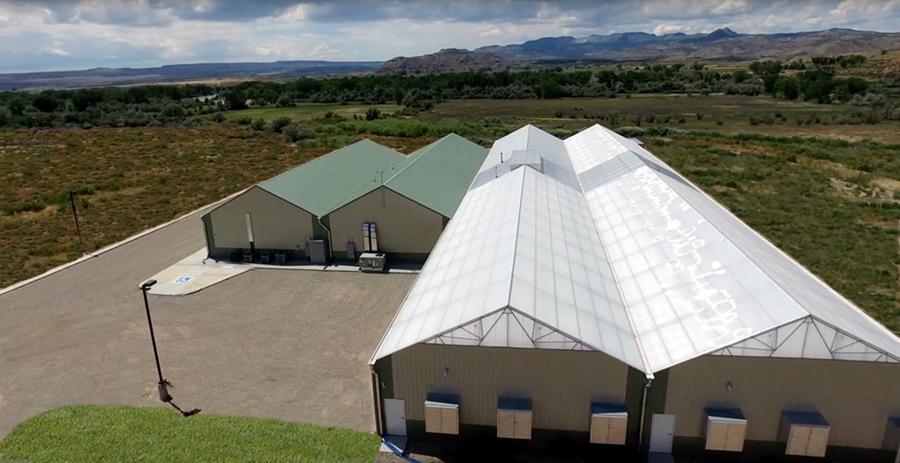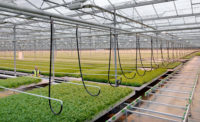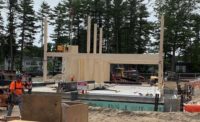In the small town of De Beque in far western Colorado, an area known mostly for its herds of wild horses, the owners of a uniquely designed, sustainable cannabis-grow facility called District 8, are benefitting from ample sunshine and an abundant supply of water from the nearby Colorado River.
Colorado is one of 29 states and the District of Columbia that has made medical marijuana legal, though federal law still bans it. Both medical and recreational marijuana are legal in Colorado.
“We were among the first to realize the future of cannabis would be in greenhouses that provide substantial cost savings by using solar energy to grow plants versus the electric grid,” says Trevor Taylor, District 8’s chief operating officer.
The 240,000-sq-ft recreational-grow facility broke ground in December 2015 and nearly 33,000 sq ft of its greenhouses and warehouses is now complete. The facility includes 22,000 sq ft of canopy space and 11,000 sq ft of drying post-harvest space. Full completion is scheduled for 2020, with phase two of construction expected to begin within six months.
While Taylor would not reveal the cost of the self-performed project, he said it has received funding from a private investor.
Recently, the owners—Taylor, District 8 Chief Compliance Officer Antonio Russo and Marques Harris, former NFL linebacker for the San Francisco 49ers and a native of nearby Grand Junction, Colo.—have been in discussions about plans to carve out a medical marijuana-grow area, Russo says.
“We have the cleanest cannabis,” Russo says. The operation does not use any herbicides, fungicides or pesticide chemicals, and it recycles its soil.
At additional cost, the facility was built to accommodate Federal Drug Administration and other regulated department guidelines in the hope of cannabis becoming legal on the federal level one day. “We are long-term thinkers and want to continue to pioneer the industry,” Russo says.
High-Tech Controls
“Our building is a high-tech greenhouse, controlled by many different parameters within the building that report back to a Wadsworth [Seed] Control System that opens and closes shutters and curtains to let sunlight in or block it out, and changes the humidity and temperature,” Taylor says.
The system has a touch-screen interface and can graph data from sensors, including sunlight, temperature, humidity and mechanical equipment for heating, ventilation and irrigation.
The challenge was managing the intricate details of building a cannabis facility that is different from a standard greenhouse,” Taylor says.
“While a traditional greenhouse is open to the environment, bugs, dust and pollen, a cannabis greenhouse is a fully enclosed ecosystem or environmentally controlled biodome.”
“We engineered an internal ecosystem, so all of our air ducts and supplied air are bug-trapped and netted, but we still have the ability to use the sun,” he says. “Then, we enclosed all of our air intakes, put them internal to the building and used screens and netting to keep dirt and dust particulates out. Screens open and close as the building demands.”
Retired contractor Greg Chaffee, who led the construction team, says, “the team was incredible, with the full construction phase finishing in less than five months.”
This was Chafee’s first sustainable cannabis facility project, Taylor says.
Design and Engineering Challenges
Creating the cooling system was a big piece of the overall phase-one design work for District 8, says Paul Golden, an environmental engineer at Nexus Greenhouses Systems, the project’s greenhouse designer.
“First, I figure out how much air movement is necessary inside to keep the greenhouse from overheating, since light is the primary source of heat, even in winter,” he says. Nexus uses national standards for designing the cooling systems for greenhouses.
“The amount of airflow necessary for greenhouses during the peak heat of the summer is about one air exchange per minute, a high rate,” Golden says. “Since District 8 has large grow zones, it requires special engineering to guarantee that air exchange. “
The cooling system utilizes four pieces of equipment—including insect screening, two sets of light traps—one over the evaporative pad-cooling system and another inside the exhaust fan housing—and the evaporative pad-cooling system. Fans and the evaporative pad-cooling system can keep temperatures below the outdoor ambient air temperature. In conjunction with each other, the equipment provides proper temperature and humidity control in the greenhouse but also causes high resistance to airflow, Golden explains.
“All of these have to be engineered together to guarantee the room still has one air exchange per minute and that the fans won’t overwork and burn out,” he says. “Starting from the intake and exhaust side, insect screening can have the highest amount of resistance.”
District 8’s facility was uniquely engineered to hold the insect screening. “One of our signature designs in the central corridor is the air intake,” otherwise known as the plenum or “lung,” Golden says. Used for housing the insect screening, the plenum brings in outdoor air through a roof screen in the roof vents above the corridor, he says.
“In areas where it’s cold, the air is preheated in the plenum to avoid shocking the plants in the greenhouses, or we heat the air in areas of high humidity to decrease the humidity,” Golden says. “For each 20 degrees F you increase the air temp, you double its capacity to hold moisture.”
While De Beque, located in plateau country near the Utah border, doesn’t get as much snow as a Colorado mountain town, the structural team accommodated for roof snow loads by increasing the number of trusses and columns, Golden says.
“We went from 12-ft column spacing down to 8- or 10-ft-column spacing to take on that snow loading…and upgraded the trusses with a thicker [galvanized] steel,” Golden says.




